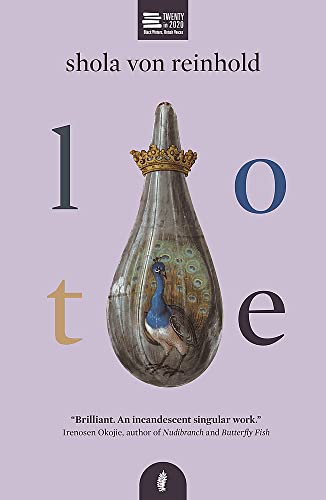WINNER of both the Republic of Consciousness Prize for Small Presses in the United Kingdom and Ireland and the James Tait Black Memorial Prize, Lote mixes real individuals like British socialite Stephen Tennant with fictional characters, as well as first- and third-person narration and excerpts from the imagined book Black Modernisms.
In Lote, things are set in motion when Black writer Mathilda Adamarola volunteers to work in the archives of Britain’s National Portrait Gallery, which she does in part in order to pursue her rapturous “Transfixions.” Those that capture her imagination are bohemian and queer figures from the 1920s and ‘30s, such as members of the Bloomsbury Group and the Bright Young Things. While there, she comes across a photograph of the decadent Stephen Tennant with a flamboyant Black woman, Hermia Druitt. Fascinated, Mathilda begins to search for more information about the little-known Scottish poet. This leads her to fake her way into a mysterious Residency in the small European city of Dun because Hermia had lived there.
The other Residents are followers of “Thought Art” and devotees of the esoteric theories of philosopher John Garreaux. In contrast to these austere Residents, Mathilda meets Hubert Erskine-Lilly, who shares her devotion to the same “Transfixions.” Along with a pair of seemingly sympathetic Residents, they attempt to revive the “Lote-os,” an “early Queer modernist subculture” dedicated to hedonism. From a mention of “Lote” in the Residency’s textbook, Mathilda deduces that there’s a connection between it and Hermia Druitt. Stealing into the Residency archives, she discovers an uncomfortable truth about its origins and John Garreaux Senior’s treatment of Hermia.
The novel’s prose occasionally veers into the florid, befitting Mathilda’s fascination with the Bright Young Things: “That winter, we sorted the wheat from the chaff, binned the wheat, and made ambrosia and nectar from the chaff. … [W]e fed on Style, having flambéed Substance with a bottle of cherry liqueur and a dramatically dropped match.” With the Residency, its ascetic, overly serious participants, “Conveyors” (facilitators), and the reclusive leader Garreaux, von Reinhold comically parodies the dense language and severe attitudes of some artistic, literary, and philosophical theories.
Lote also critiques the ways in which Black artists in general, and Black women artists in particular, have been ignored, mistreated, and suppressed by the mainstream art world. Von Reinhold writes: “Black people consuming and creating beauty of a certain kind is still one of the most transgressive things that can happen in the West, where virtually all consumption is orchestrated through universal atrocity.”
Originally published in the U.K. in 2020, this challenging, multi-layered novel may not be everyone’s glass of pink champagne, with its view of eccentricity, excess, and languor as a route to a kind of queer utopia. Those willing to escape into its world, however, will find Lote to be a fascinating and challenging experience.
Reginald Harris, a writer and poet based in Brooklyn, is the author of Ten Tongues (2003) and Autogeography (2013).







